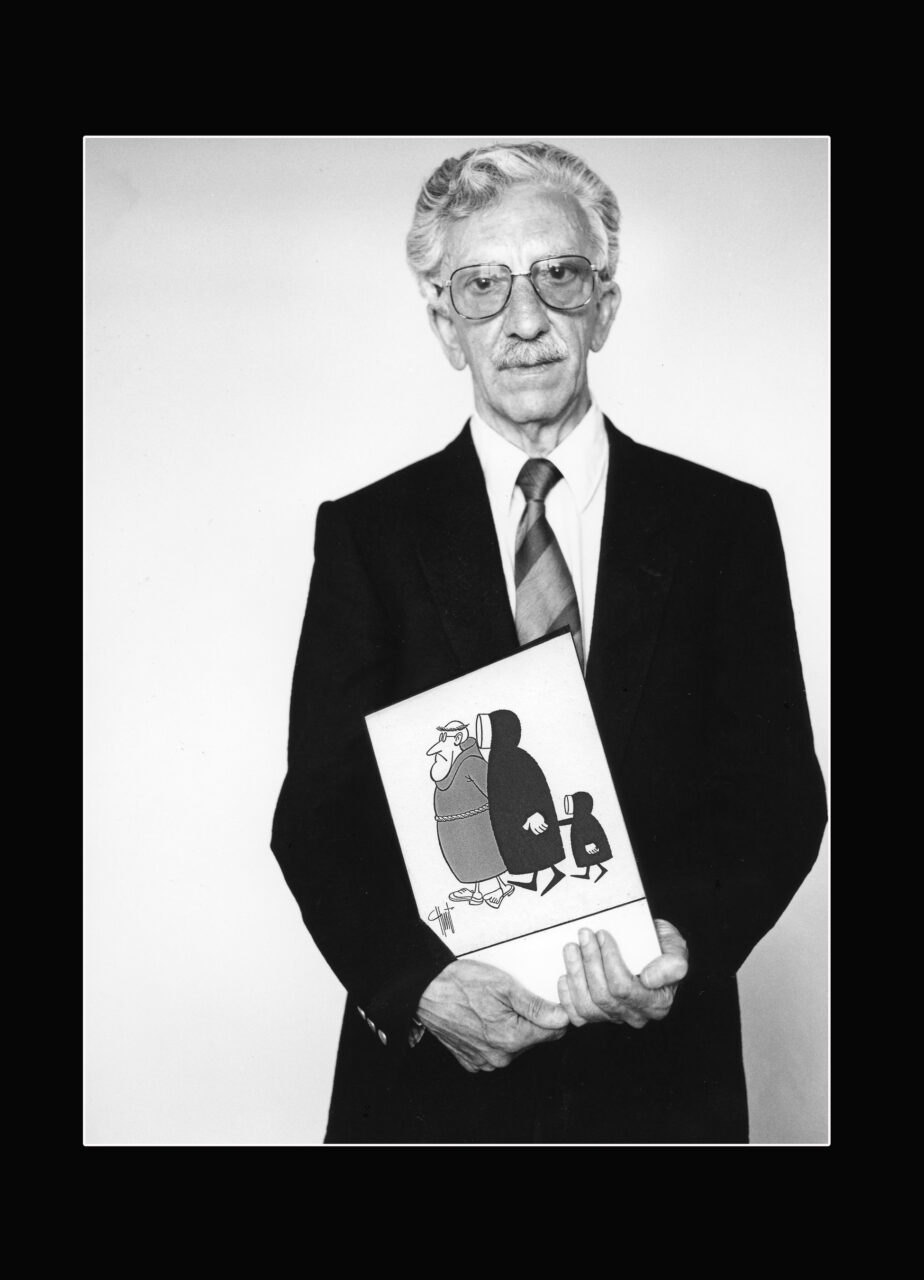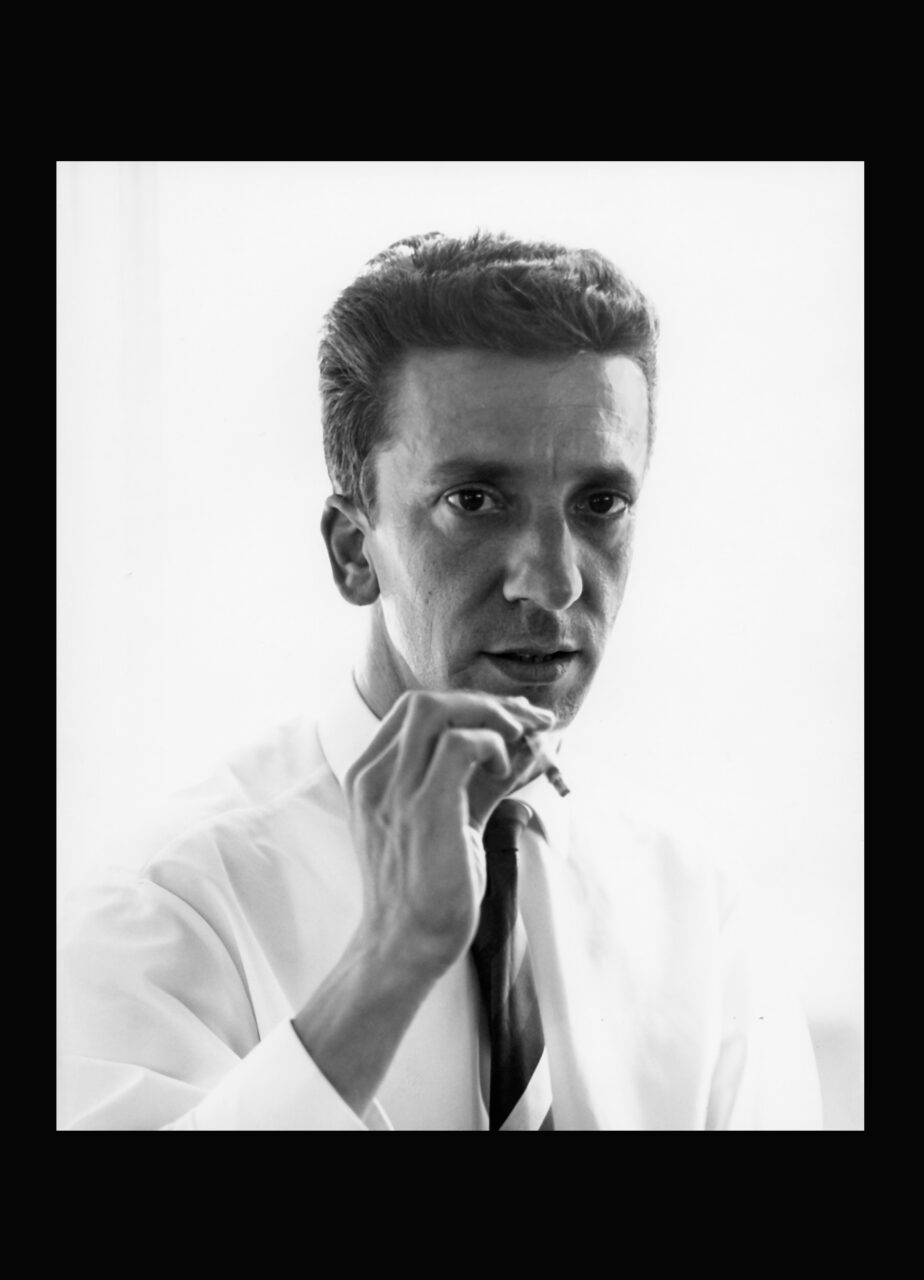Who was Gèr Huntjens? (1927- 2009)
Gèr Huntjens was born in Kerkrade, the Netherlands, in 1927. He spent his youth in Oud-Valkenburg and the rest of his artistic life in Maastricht.
Gèr did not like being in the limelight and worked in a very modest way. A well-known journalist once wrote of him: “If he had worked elsewhere in the country, where the big advertising agencies are located, he would soon have worked his way to the top – at least if his mouth had been as big as his work was powerful. Huntjens is an exceptional artist, who is hardly known in his own part of the country”.
Gèr Huntjens was an artistic philosopher. He observed people, studied them and set down his verdict in a cartoon. He understood the art of freezing someone in their situation, with no need for texts or explanations. His cartoons still elicit a smile or even a roar of laughter. You understand the comedy of the situation immediately, but Gèr saw it before you and recorded it in the controlled lines of his graphic skills.
Maybe because speech and writing were not his strongest points, nobody understood the art of writing without words like Gèr. He could express his whole personality just through his precise lines and brilliant division of surfaces.
Exhibitions
At the foundation of the ‘Henry Jonas’ art circle in Valkenburg, in 1947, the press already picked him out as a talented young artist with great promise.
In 1955, he took part in the important Contour exhibition in Het Prinsenhof in Delft (de Vaderlandse Biënnale), along with artists like Karel Appel, Gene Eggen, Edgar Fernhout, Aad de Haas and Wim Noordhoek.
In December 1959, he took part in the exhibition Grafiek uit Nederlands Limburg in Hasselt, alongside Gene Eggen, Aad de Haas, Hubert Lévigne, Jac. Van Lijf, Emile Taalman and Max Verboeket
1970: Exhibition in the Kritzraedthuis in Sittard with three other prominent Dutch cartoonists.
1975: Exhibition of 250 Hunt cartoons and graphic works in Maastricht at the opening of the exhibition space ‘t Klokkehoes, and in the same year an exhibition of his cartoons in Sittard Hospital.
1991: Exhibition of the first graduates of the Jan van Eyck Academy, organised by Arts-Agency.
Gèr Huntjens won two notable and very different awards: first prize for a work executed in gouache at the Milan Biennial, in 1955, and the ‘Gouden Noot’ for his packaging designs, in 1959.
Gèr Huntjens died at the age of 82 in Maastricht, at Christmas time in 2009.
He was blessed with great talent, which through his own agency went almost unnoticed.


What did Gèr Huntjens do?
Gèr Huntjens studied at the Stadsacademie van Maastricht and graduated with distinction from the Jan van Eyck Academy in Maastricht.Hubert Lévigne was his most important teacher at the academy, especially as far as graphic art was concerned.
Gèr started working as a designer with the Kristalunie in Maastricht and went on to become a graphic designer with the larger printing firms in the same city. He produced many industrial designs, from beer mats to church windows and everything in between. He applied his art to large posters, illustrations, corporate styles and logos, book covers, brochures and packaging.
He worked, for instance, on creating the coloured glass marketed by the Kristalunie under the name ‘Carnaval’, which conquered the world. He also designed the stained glass windows of the St. Bavo church in Breda.
In a different class altogether, he designed the mascot of the Regio Zuid police and the logo of the Maastricht metropolitan police.
He also illustrated books by such renowned writers and poets as Felix Timmermans and Mathias Kemp.
He was an equally enthusiastic practitioner of graphic design on small consumer items, such as devotional pictures, ex libris, invitations, and birthday, birth announcement, memorial, new home and Christmas cards.
No matter how small or apparently insignificant the item, the inner power of his style was always clearly visible.
Under the pseudonym ‘Hunt’, Gèr became best known for his cartoons in the Dutch weeklies, such as Panorama, de Katholieke Illustratie, Nieuwe Revu and Elsevier Select, and German weeklies like Hör Zu, Quick and Neue Revue. His cartoons were also regularly published in Switzerland, Belgium and France. He gained international recognition as a cartoonist for his illustration on the cover of Knaus Lachende Welt, the leading European cartoon book. Four volumes of his cartoons, entitled ‘Hunthumor’ were published in Maastricht.
But he turned out to be a very versatile artist. Besides his work as a graphic artist, designer, glass artist and cartoonist, he was also a painter. Huntjens the painter was inspired by the Surrealism of René Magritte, for example.
In Gèr’s works, you see the accomplished graphic artist giving free rein to his imagination. Each of his paintings is a technical gem.
Although there was interest in his work as far afield as America, Gèr preferred to lead a quiet and secluded life. He was not interested in fame and glory.
This is why his works were seldom exhibited over the years.
Exhibitions
1955 Contour tentoonstelling, Delft
1959 Grafiek uit Nederlands Limburg, Hasselt
1970 Expositie in het Kritzraedthuis, Sittard
1975 ‘t Klokkehoes, Maastricht
1991 Jan van Eyck Academie, Maastricht
2017 Museum Valkenburg, Valkenburg aan de Geul
Prices
1955 the highest price poster paint, Biënnale van Milaan
1959 de ‘Gouden Noot’ for his packaging design
